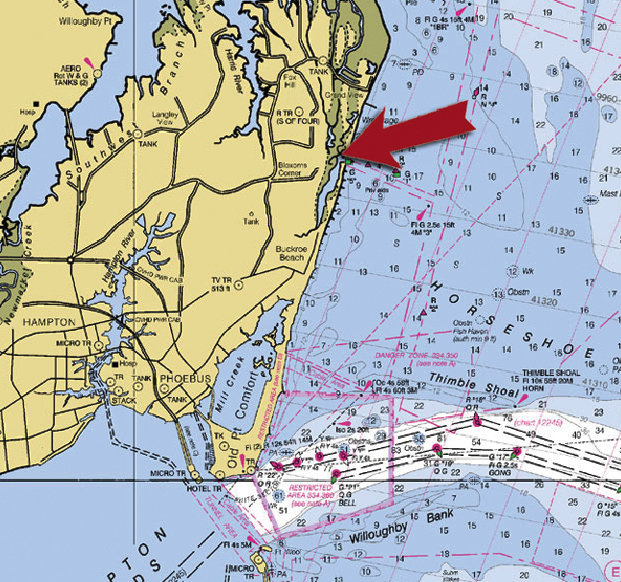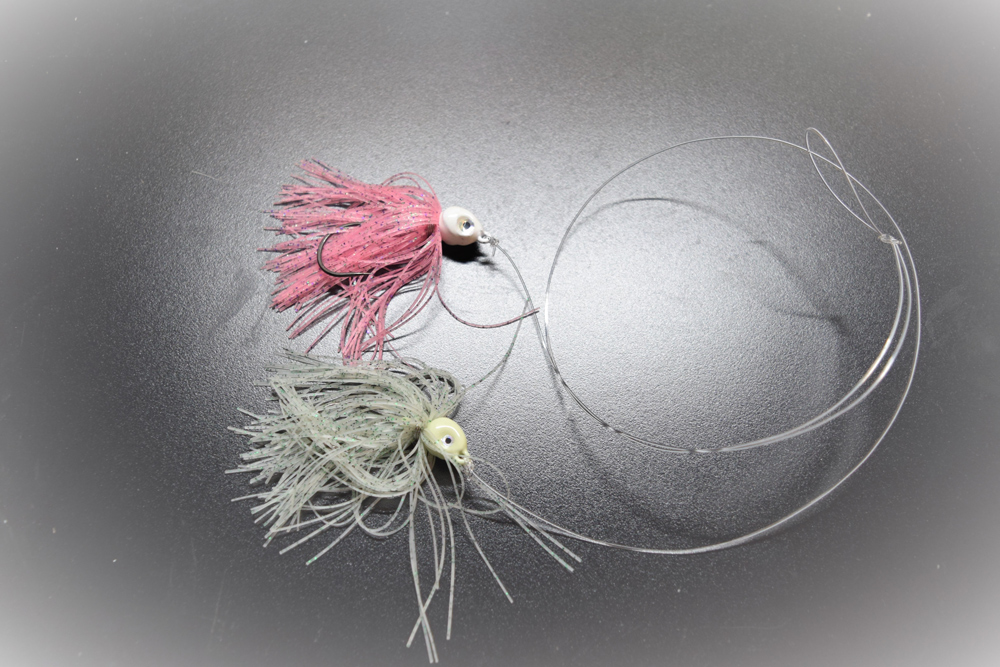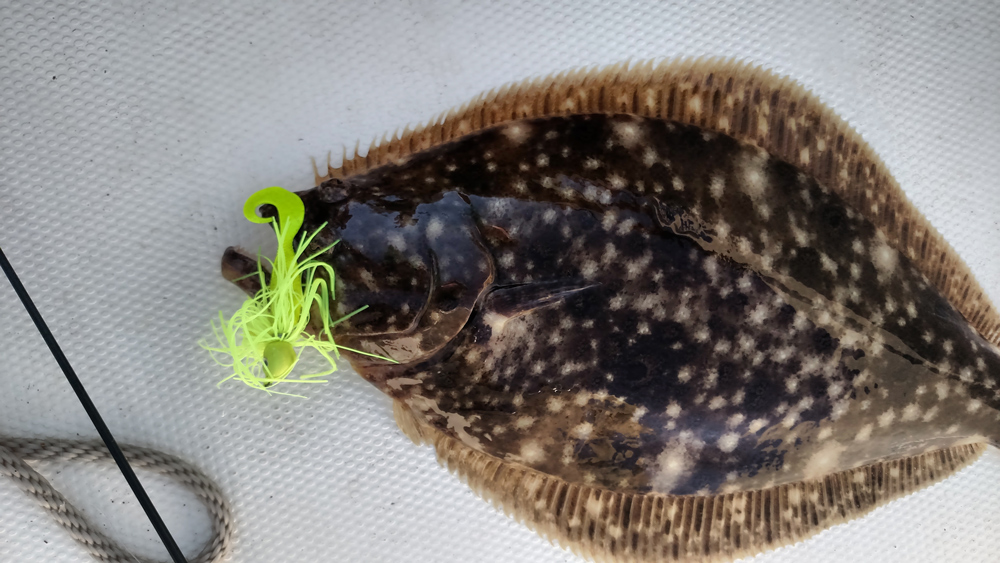I’m convinced that in the early spring flounder, like many species, swim into the Chesapeake Bay along the western beaches and keep swimming until they find slightly warmer water in areas like off Buckroe and Grandview in Hampton, VA. This is also why some of the first early spring cobia in Virginia are caught in these same waters in May. This broad area of relatively shallow water warms before a lot of the surrounding areas. The crabbers know this. They set their pots in this area in spring. I believe that all this crab bait is another reason the flounders are attracted to the Hampton area – it’s like a giant chum slick.

This fishery is very weather dependent. Some years our area enjoys mild, warming weather through late March and early April. Other years the temperatures are on a roller coaster, with lots of wind and rain. The fishing is better on those milder years when the water temps have the chance to gradually warm, and the water stays fairly clear.
KISS Flounder Tackle
This is shallow water fishing on sandy bottom, so light tackle is all you need. I use spinning outfits and light-weight baitcasting reels spooled with 20-pound braid line. Depending on the wind and current, I use jigs from one half to two ounces, and bottom rigs with two- to four-ounce sinkers. The rule of thumb is to use the lightest jig and sinkers the current will allow. I use two kinds of jigs. One is a standard one-half ounce leadhead with a three- or four-inch GULP Swimming Mullet in white or yellow. The other jigs I use come from Backwater Baits in a variety of sizes up to several ounces. I use the bigger ones when jigging the piling of the Chesapeake Bay Bridge Tunnel later in the season, but in the shallow I use smaller ones of one and a half to two ounces. These jigs have rubber skirts and come in a variety of colors. I’m not sure the color matters so much to the fish, but I love chartreuse, pink, and white ones. I also add a GULP tail to these. When small bluefish are a problem I’ll switch to Z-Man plastic tails on the leadhead (Z-Man makes heads specifically for these). On the Backwater jigs, substituting a strip of squid or fresh cut strips of croaker works well.
Along with the jigs I’ll usually pull a conventional flounder bottom rig. This consists of a three-way swivel, with a one-foot leader to the sinker. On the other eye of the swivel is a three-foot leader with a 4/0 or 5/0 octopus style hook. Sometimes I dress the hook with a squid skirt or bucktail, but a lot of folks swear by a “naked” hook with a squid strip and minnow in the early season. Strips should be about a half-inch wide and four- to eight-inches long, depending on the size flounder that are around.

Since I do a lot of fishing by myself, I employ the “RH Factor”. In other words, one or more rods go in the rod holder. Typically, I’ll put the line with the conventional rig and cut bait in the rod holder while hopping the jig along the bottom, or continually shaking it just off the bottom. A few anglers have posted underwater videos on YouTube of flounder fishing. These videos show that, contrary to what we used to think, flounder will swim along behind a bait for quite a ways before striking it.
If the current is slow, tossing the one-half ounce jig out to the side of the boat and working it back allows you to cover a bit more ground than simply dragging all the baits behind the boat. Another trick is to switch to a rig with two jigs. Simply tie two jigs of different sizes onto a three-foot piece of leader. Tie a loop in the leader about a foot above the lighter jig, using a surgeon’s knot. Attach the loop to your running line and you’re ready to go. The heavier jig will come into contact with the bottom while the lighter one will swim just above it. Speaking of leaders: I always use fluorocarbon in the 15- to 20-pound test range attached to the running line (usually braid) with a double uni-knot.
Flounder hit a jig differently than they strike bait. With a longer strip bait the flounder bites the tail end of the bait first and if you try setting the hook you’ll miss the fish. Drop the rod tip, and even play out a little line until you feel a knock-knock-knock. This usually indicates he has worked his way up the bait to the hook. But they attack jigs with abandon, and usually get hooked right away.
Spring Flounder Hotspots
For the past few years I’ve focused more towards the inlet at Salt Marsh. A lot of bait comes in and out of that inlet. They are doing a big dredging operation up there this year, and it will be interesting to see if this changes the dynamic. Try drifting across the channel anywhere from the jetties out to the second day-markers. The channel is not very pronounced, but does offer a little change in depth. There are some old shell beds in this area, which is also a good thing.
Further down the beach towards Buckroe, look for the shallow water near where it begins to drop off. This area becomes covered with crab pots during the spring, which is a tradeoff. On the one hand, as I mentioned I believe all that bait from the pots in the water is a good thing. On the other hand, you must keep a constant eye out to avoid snagging a pot with your hook or wrapping a pot line around your prop.
It goes without saying that when you catch a flounder, it pays to work that area hard. These fish are not loners! They may not be all bunched up right together but they move in schools and settle into a pattern. So if you caught the fish where the water dropped from 10 to 15 feet, keep working similar drops in that area.

Patience is key this time of year. I’ve never loaded up on a bunch of fish in a short time, but I have had days when I caught several keeper fish over a few hours’ time. Plus this early in the spring, the small croakers and other species that will soon pave the bottom aren’t yet a problem.
OK, these fish aren’t really “halibut,” but they are close cousins. And on light tackle, they’re a lot of fun to catch – not to mention how good fresh flounder tastes after a long winter spent eating last year’s fish out of the freezer.
- by Chuck Harrison
Sign up here to get the weekly FishTalk Chesapeake Bay and Mid-Atlantic fishing reports in your email inbox, every Friday by noon.